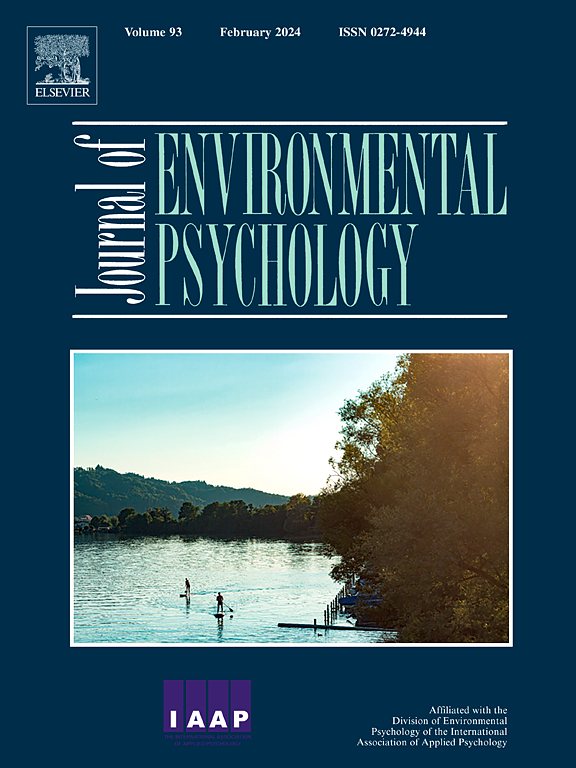Understanding place attachment profiles among natives, internal and international migrants
IF 7
1区 心理学
Q1 ENVIRONMENTAL STUDIES
引用次数: 0
Abstract
In recent years, migration and people's mobility have raised questions on how people bond with places, as mobility challenges traditional views on rootedness and fixed bonds with a place. Thus, this paper tackles the relationship between people and the places they live in by investigating place attachment profiles among different mobility-experienced groups. Specifically, the present study set out to identify attachment profiles based on different types of attachment – traditional, active, and place relative – and characterize these emerging latent profiles in terms of place identity motives, socio-demographics, and how they are expressed differently among natives and migrants. Six hundred and forty-four participants' survey answers were collected in two densely migrant-populated urban case studies in Belgium and Portugal. The results reveal four distinct attachment profiles: non-traditional, active non-relative, active relative, and traditional-active. The first three were found to be more prominent among recently arrived international migrants, while internal migrants are present in all profiles, and natives in the traditional-active profile. With regard to place identity motives: Distinctiveness, continuity, and belonging needs were less fulfilled for migrants, while self-efficacy was similar among groups. These findings help us understand how migrants bond with their new place and how people's attachment profiles can be nuanced in terms of their type of attachment and acceptance of change in their place.
了解本地,国内和国际移民的地方依恋概况
近年来,移民和人口流动引发了人们对人们如何与地方联系在一起的问题,因为流动性挑战了关于扎根和与地方固定联系的传统观点。因此,本文通过调查不同流动经验群体的地方依恋概况来解决人与他们居住的地方之间的关系。具体而言,本研究旨在确定基于不同类型依恋(传统依恋、主动依恋和地方相关依恋)的依恋特征,并从地方身份动机、社会人口统计学以及它们在本地人和移民之间的不同表达方式等方面描述这些新兴的潜在依恋特征。644名参与者的调查答案是在比利时和葡萄牙两个移民人口密集的城市案例研究中收集的。结果显示了四种不同的依恋类型:非传统依恋、主动非亲属依恋、主动亲属依恋和传统-主动依恋。发现前三种情况在最近抵达的国际移民中更为突出,而国内移民出现在所有情况中,而本地人则出现在传统的活跃情况中。关于地方认同动机:移民的独特性、连续性和归属感需求较少得到满足,而群体间的自我效能感相似。这些发现有助于我们理解移民是如何与他们的新地方联系在一起的,以及人们的依恋概况如何在他们的依恋类型和对他们的地方变化的接受程度方面变得微妙。
本文章由计算机程序翻译,如有差异,请以英文原文为准。
求助全文
约1分钟内获得全文
求助全文
来源期刊

Journal of Environmental Psychology
Multiple-
CiteScore
10.60
自引率
8.70%
发文量
140
审稿时长
62 days
期刊介绍:
The Journal of Environmental Psychology is the premier journal in the field, serving individuals in a wide range of disciplines who have an interest in the scientific study of the transactions and interrelationships between people and their surroundings (including built, social, natural and virtual environments, the use and abuse of nature and natural resources, and sustainability-related behavior). The journal publishes internationally contributed empirical studies and reviews of research on these topics that advance new insights. As an important forum for the field, the journal publishes some of the most influential papers in the discipline that reflect the scientific development of environmental psychology. Contributions on theoretical, methodological, and practical aspects of all human-environment interactions are welcome, along with innovative or interdisciplinary approaches that have a psychological emphasis. Research areas include: •Psychological and behavioral aspects of people and nature •Cognitive mapping, spatial cognition and wayfinding •Ecological consequences of human actions •Theories of place, place attachment, and place identity •Environmental risks and hazards: perception, behavior, and management •Perception and evaluation of buildings and natural landscapes •Effects of physical and natural settings on human cognition and health •Theories of proenvironmental behavior, norms, attitudes, and personality •Psychology of sustainability and climate change •Psychological aspects of resource management and crises •Social use of space: crowding, privacy, territoriality, personal space •Design of, and experiences related to, the physical aspects of workplaces, schools, residences, public buildings and public space
 求助内容:
求助内容: 应助结果提醒方式:
应助结果提醒方式:


